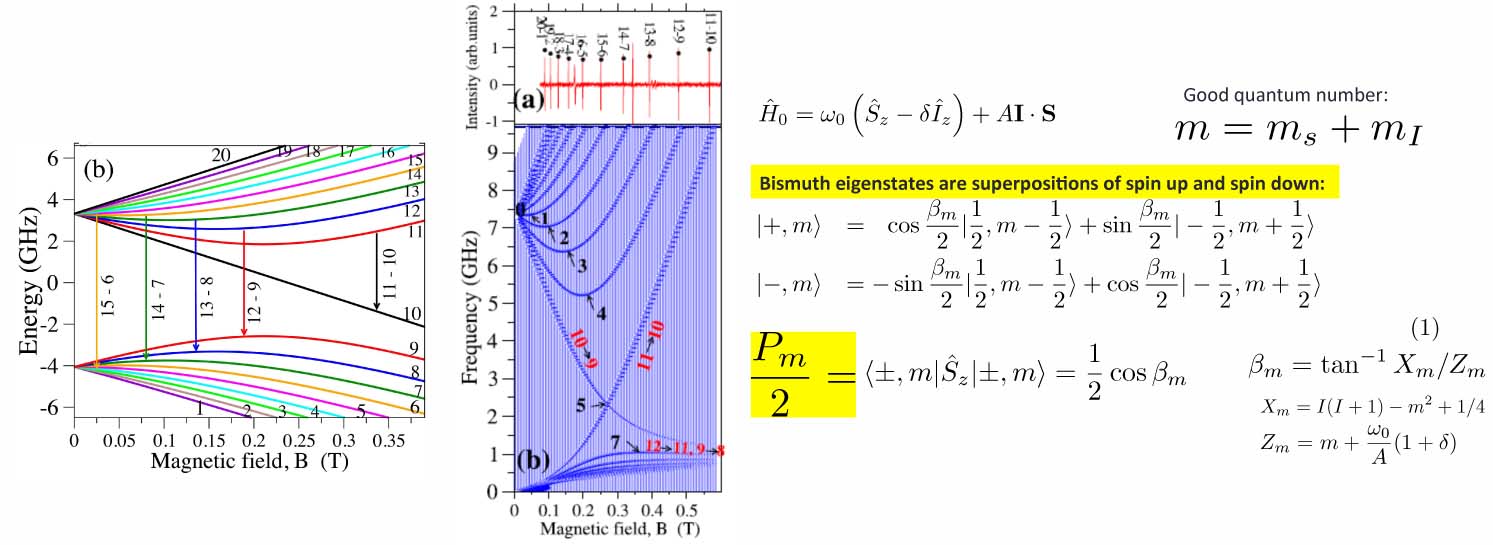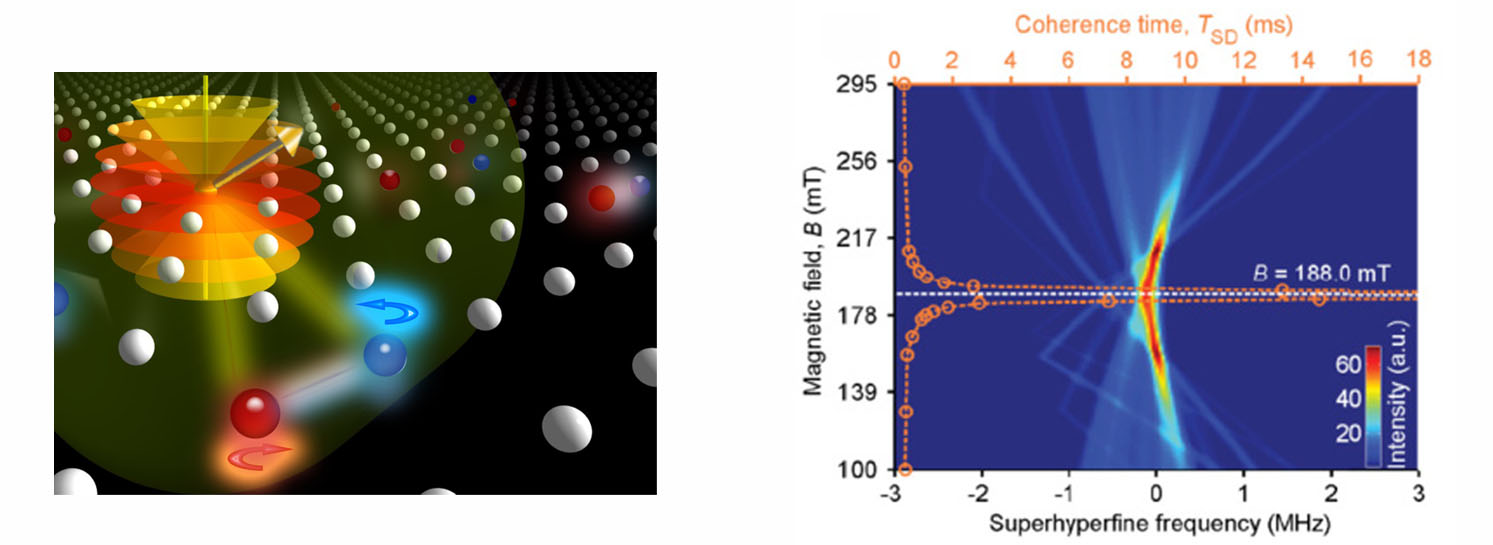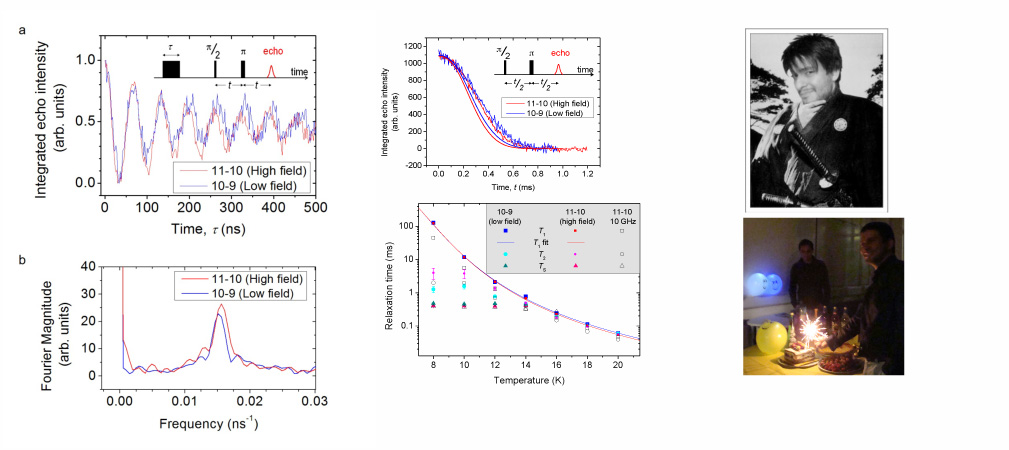Bismuth qubits
![]()
Bismuth qubits
In the famous Kane proposal, electron spins form natural qubits for informations processing as they interact relatively strongly and can be easily initialised and manipulated. However a quantum state typically loses its coherence on millisecond timescale. On the other hand nuclear spins are more useful as memory registers as they interact weakly with their environment so a quantum state loses its coherence much more slowly. On the other hand they are harder to manipulate: the magnetic dipole of a nuclear spin is of order 1000 times smaller than for the electron so transitions between nuclear states (NMR) are correspondingly much slower than for electronic states (ESR). At UCL bismuth silicon donor qubits were proposed as a novel variant of this in 2010 (Morley et al Nat. Mat. 9, 725 (2010)):

![]()
Hybrid electron-nuclear qubits
In Mohammady et al Phys.Rev.Lett. 105, 067602 (2010) we investigated theoretically and experimentally the advantages of bismuth donors in silicon as spin qubits. In this case, the electron spins are not simply "spin-up" or "spin-down" but acquire a characteristic tilt angle beta (see below) which depends on the competition between the external magnetic field and the coupling strength A between the electron spin and the host (the bismuth’s own) nuclear spin. By measuring unsaturated spectra, Morley showed for the first time that very strong mixing (hybridisation) effects were already seen in the X-band spectra - apparent in the slight “V-shape" of the heights of its 10 spectral lines. in contrast, the first spectra obtained appeared quite flat with no apparent hybridisation. We identified a series of special points in the spectra which might have advantages for decoherence suppression or fast manipulation of transitions which are usually slow. We also investigated suppression of bismuth-bismuth interactions which are dominant in the case of isotopically enriched samples.

![]()
Decoherence of hybrid qubits
In MH Mohammady, GW Morley , A Nazir and T.S.Monteiro Phys.Rev.B 85 094404 (2012) the decoherence of bismuth donor qubits by classical noise was investigated.
While in S.J.Balian, M Kunze, M.H.Mohammady, G.W.Morley, W. Witzel, C.W.Kay, T.S.Monteiro Phys.Rev.B 86, 104428 (2012) the loss of coherence was investigated as a quantum bath. For samples of bismuth qubits in natural silicon, decoherence occurs because of magnetic noise from flip-flopping nuclear spins. Most of silicon is in the form of the 28^Si isotope which has zero nuclear spin; but about 4% of the silicon lattice is occupied by 29^Si atoms which have nuclear spin=1/2. Neighbouring 29^Si nuclei exchange spin states: they "flip-flop" causing a loss of phase coherence in the quantum states of the electronic qubit. The left panel below shows a pair of flip-flopping 29^Si nuclei.
For a classical bath the perturbation appears as a fluctuation of the frequency f of the qubit transition of interest. It is expected that the coherence time will scale as df/dB:
tracking the sensitivity of the frequency to a change in magnetic field. At optimal working points, because the tilt angle of the quantum energy levels becomes equal,
one expects complete insensitivity to magnetic fluctuations.
However, the quantum bath calculation is dependent on entanglement and back action on the bath. In Balian et al 2012, a quantum bath calculation near OWPs showed orders of magnitude enhancements in coherence, but the df/dB dependence was not so apparent.

![]()
Best of both worlds hybrid qubits
In G.W. Morley, P.Lueders, MH Mohammady, SJ Balian, G Aeppli et al Nature Materials 12, 103-107, (2013) we were able to demonstrate manipulation of a nuclear (NMR) and a electronic (ESR) transition at the same rate because of the strong mixing between the nuclear and electronic degrees of freedom. Strictly speaking, best-of-both-worlds, in the sense of a transition operated at electronic speeds, but with nuclear coherence times, occurs at the
optimal working points (OWPs) that we had investigated previously. A problem with accessing the best-of-both operating points is
that the most common spectrometers operate around 9 GHz, while the
most interesting OWPs -where electronic decoherence is suppressed- are in the 5 to 7 GHz range. In this case, Hamed Mohammady, the PhD study took a bismuth sample (natural silicon) to Zurich, where there was a 4 GHz spectrometer, to demonstrate speed-up of the usually slow nuclear transition (left panel). The experimental study was then undertaken with the group of Prof G. Jeschke. A comparison with usual 9 GHz regimes (X-band) presented in this work (center panel) showed no enhancement in coherence arising from suppression of the nuclear bath, as expected. An attempt was made to also infer the donor-donor contribution which would dominate in an isotopically enriched sample but this was not convincing, as these effects are masked by the nuclear spin bath.

Hamed Mohammady (right) graduated with a PhD in 2013. He moved to a Marie Curie Fellowship in Lisbon. He works on quantum foundations and quantum thermodynamics.